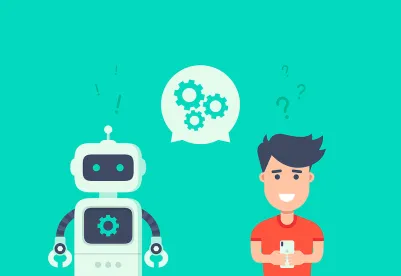Artificial intelligence/machine learning (“AI/ML”) tools have recently taken center stage in the popular imagination. So far, most news articles focus on the potential benefits to customer engagement, user interface/user experience (“UI/UX”) enhancements, reductions in time-to-market and even more general software coding. However, some articles focus on more disturbing implications of chatbots breaking free of their content restrictions or their seeming existential crises. Not nearly as many articles have focused on the important legal considerations associated with these tools.
The benefits of AI/ML tools or AI/ML generated content are real and undeniable; however, using these tools comes with legal risks not immediately apparent. Some risks arise out of the terms and conditions associated with the use of the services themselves, namely through queries input into the service or the output generated from those queries; some are inherent to the functioning of these AI/ML tools and how they were trained. Navigating and mitigating these risks will be crucial to maximizing the utility and benefits.
As of this writing, OpenAI’s ChatGPT has captured the popular imagination of the public and as a result will be the primary example discussed in this article. However, it should not be forgotten that other significant tools are also in play such as Bard by Google, OPT by Meta, AWS Chatbot by Amazon and the untitled services offered by Alibaba and Baidu.
When evaluating the use of AI/ML tools, there are three main risk mitigation categories for any business to consider that we are highlighting: (1) Understanding the specific terms and conditions associated with the use of the specific tool; (2) the interface between the uses of these tools and intellectual property creation and ownership; and (3) the impact the use of these tools could have on transactional due diligence. Of course, these are not all the legal considerations for businesses to consider as AI/ML tools interplay with the complex operations of many organizations, including those with domestic and international operations.
Understanding the Terms and Conditions:
For obvious reasons, the users of AI/ML tools do not exclusively control the process – prompts (inputs) are provided, processing occurs, and outputs are generated. A user’s rights are largely governed by the terms and conditions associated with the tool.
For example, ChatGPT’s terms state that while users “own” the input and output, OpenAI retains certain abilities to use the inputs and outputs to improve and maintain its services. OpenAI notes that similar inputs will inevitably result in similar outputs; so a user’s exclusivity may be coincidental. These aspects may limit the value of the tool from a business viewpoint, depending on the intended application.
Further, ChatGPT also makes no representations about third-party infringement. The output from ChatGPT is “as-is, where-is” leaving the user to evaluate intellectual property infringement risk without the benefit of knowing or understanding ChatGPT’s source material. This can mean that ChatGPT output could be based on, for example, copyrighted software code licensed on a copyleft basis and subjecting a project that incorporates ChatGPT’s output to an inadvertent and likely unknown obligation to make its proprietary source code available to the public and restricting the user’s ability to offer commercial licenses. Other more obvious examples include the creation of derivative works based on images, audio clips or portions of texts that are digitized and searchable.
Relatedly, input queries (either individually or collectively) to chatbots may constitute the unauthorized disclosure of confidential information. OpenAI’s terms permit it to use that material to improve its services. This might include the aggregation of input queries and output generated therefrom which OpenAI may use or provide in response to other queries. Unauthorized and uncontrolled disclosure of this information through chatbot queries could also potentially eliminate trade secret protection.
None of this disparages OpenAI and its terms and conditions, but rather alerts the reader to the realities associated with reliance on these tools.
AI Generated Content Is Not Patentable or Copyrightable:
Second, AI/ML output is currently not eligible for patent or copyright protection under U.S. law. With copyright rights, failure to meet the requirements for copyright protection means that the source material is deemed to be in the “public domain” and freely available for use by anyone. In at least one case, the U.S. Copyright Office has cancelled a previously granted registration and issued a new, very limited registration due to its discovery that previously copyrighted images were in fact AI/ML generated. Based on recent guidance published by the U.S. Copyright Office, anyone considering copyright protection for material (e.g., images, text, or software) generated using AI/ML tools or which contain AI/ML generated content should consider obtaining legal guidance prior to filing, as the U.S. Copyright Office has made the application of law to the use of AI/ML tools and output a priority for action in 2023 and beyond.
AI/ML Generated Content and Transactional Representations and Warranties:
Finally, because of the potential impacts discussed in this article, it may be appropriate for a business to consider whether an enhanced emphasis should be placed on the use of any AI/ML tools or AI/ML generated content, including due diligence review or any intellectual property representations and warranties, as part of licenses, technology transfers, or other business transactions. Businesses using AI/ML tools or AI/ML generated content should consider proactively evaluating or addressing any of these potential business risks, particularly because of the possibility that certain intellectual property protections may not be available, or that registered intellectual property may not be valid or enforceable if AI/ML algorithms made contributions to those works or inventions. Further, Operations Support Systems (“OSS”) related representations and warranties may be impacted where AI/ML coding has been incorporated into a code base, unless a party can provide a strong representation relating to the license status of the universe of “source” material. While the use of AI/ML tools or AI/ML generated content can be very beneficial, it’s important to identify and mitigate any risks on a prospective rather than a retroactive basis.
Use AI/ML to Enhance Your Business – With Caution:
While AI/ML chatbots are in their relative infancy, and the landscape of what is possible in terms of AI/ML capabilities is changing on a daily basis, businesses would be well advised to consider whether using AI/ML chatbots is appropriate depending on their business generally, whether their policies and procedures should be updated to account for this new technology and possible use cases (including use by your vendors), whether additional specific employee education would be appropriate to mitigate any risks associated with that use, or whether specific AI/ML chatbot policies and procedures should be implemented.
Considering the detrimental impact that failing to obtain patent or copyright protection may have, the adverse effects of the unauthorized disclosure of confidential information or destruction of trade secret protection, or the increased exposure created, businesses should approach these new tools with a healthy dose of skepticism and consider the many latent pitfalls which accompany the readily available output generated from their use.





 />i
/>i

